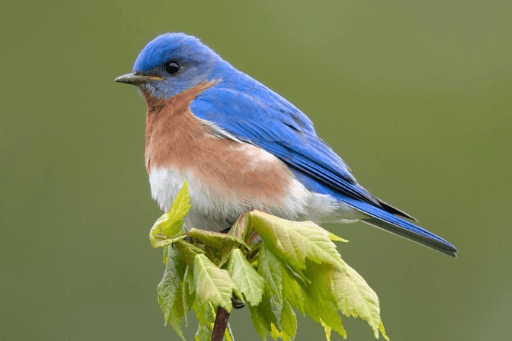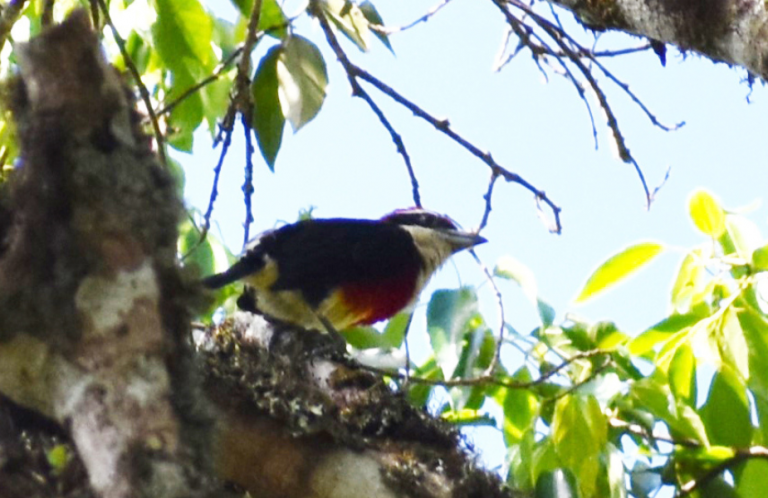Birds of Virginia: Backyard Birds
Most birders in Virginia start watching birds around their homes. The following species can be seen almost anywhere in the state, often in cities and towns. While some of the bird species included here are among the most common birds of Virginia, others are harder to find, but worth the effort.
This post is part of a five-part series in which we look at a few of our favorite bird groups in Virginia (waterbirds, grassland birds, raptors, and forest birds) by profiling some of the most captivating species in each.
Ruby-throated Hummingbird

The Ruby-throated Hummingbird is Virginia's sole breeding hummingbird, its smallest avian species, and one of the most popular eastern birds. This flower-visiting sprite is typically absent from the state in winter, arriving in early to mid-April for nesting, then departing in autumn. If you see a hummingbird during the winter months (November through March), it could be a species from the western United States: The Rufous Hummingbird and other western species are wintering in the eastern U.S. in increasing numbers.
Conservation: Planting native flowers such as Cardinal Flower, Coral Honeysuckle, and Trumpet Vine can provide food resources for hummingbirds. ABC offers additional tips on creating a hummingbird paradise in your yard or garden. Ruby-throated Hummingbirds are regular victims of window collisions and fall prey to outdoor cats. ABC has a number of initiatives addressing these mortality sources, including our Cats Indoors program and our Glass Collisions program, which offers solutions to reduce or prevent birds from hitting windows.
Locations: This energetic little bird is widespread throughout Virginia from early to mid-April through September (numbers sharply drop by early October). Thousands of Ruby-throated Hummingbirds pass through the Blacksburg area in late summer, and many can be seen around Mountain Lake Conservancy (in Pembroke), as well as at most sites where feeders are maintained.
Chimney Swift

Swifts are among the most aerial of birds, with some species spending much of the year in flight — even sleeping on the wing! Chimney Swifts often congregate in large groups during fall migration, with communal roosts sometimes attracting thousands of birds, frequently in the species' namesake open chimneys. Watching such huge flocks tumble out of the sky in bird-tornados to settle in for the night is one of the highlights of fall birding. Chimney Swifts migrate to the Amazon Basin of South America to spend the winter.
Conservation: Chimney Swift populations in the U.S. and Canada declined 67 percent, to an estimated 7.7 million birds, between 1970 and 2014. (These and other landbird trends in this blog are from the 2016 Partners in Flight Landbird Conservation Plan, available here.) Indeed, aerial insectivores in many bird families (e.g., nightjars, swallows, and flycatchers) have declined faster than most bird groups that feed on other resources. The reasons for these declines remain unclear, but declines in insect prey and widespread use of insecticides are suspected to be at least partially responsible. ABC is working to reduce harm to birds from neonicotinoid pesticides — which can be harmful to people, too. The Chimney Swift Conservation Association promotes swift-roost observation in August and September during A Swift Night Out! events, as well as swift-tower construction to provide nesting and roosting structures for these birds.
Locations: Chimney Swifts can be seen in the warmer months throughout Virginia, and can appear overhead almost anywhere. Urban areas can be great places to search for roosting sites.
Northern Cardinal

The Northern Cardinal, Virginia's official state bird, is common in residential neighborhoods and a variety of forested and shrubby habitats. Male cardinals, with their bright red plumage and crests, are among our most easily recognized birds, and their loud songs are distinct and familiar. In late summer, Northern Cardinals missing most of their head feathers are sometimes seen at bird feeders. This condition is typically caused by the bird molting all its head feathers at once, although feather mites or other factors may also be the cause. This is rarely a health issue for the bald birds, and they usually regrow these feathers quickly, regaining their attractive appearance.
Conservation: Northern Cardinal populations are doing well in Virginia. Planting native plants such as Winterberry can help provide food resources they need, including insects, and fruit in winter.
Locations: Widespread throughout Virginia year-round.
American Goldfinch

The American Goldfinch is another colorful and common bird of Virginia, widespread in neighborhoods, weedy fields, and forest edges. The bright yellow males molt into drabber plumage for winter. They often breed later in summer than do most other birds, to take advantage of late-seeding plant resources. Unlike most passerines, goldfinches feed their nestlings seeds, which makes them a poor host for cowbirds. Cowbirds lay their eggs in the nests of many songbird species, but cowbird nestlings fail to thrive in goldfinch nests because of the vegetarian diet goldfinches feed their young. Cowbird nestlings require an insect-rich diet, as do most other nestling songbirds.
Conservation: American Goldfinch populations are doing well in Virginia. Planting native plants such as Black-eyed Susan can help provide food resources they need.
Locations: Widespread throughout Virginia year-round.
Eastern Bluebird

Bluebirds are among of the most beloved North American songbirds, and will readily use human-provided nest boxes, especially at the edges of woods and meadows. Although their plumage makes bluebirds easily recognizable, we recommend learning their vocalizations to increase your chances of finding them — particularly in places you might not expect, such as flying over your home or yard if you live in areas where this bird typically does not occur.
Conservation: Bluebirds were once uncommon, likely due to competition with introduced birds for nesting cavities. Widespread nest box programs have helped boost populations. The Virginia Bluebird Society supports a network of bluebird trails, promotes awareness of bluebirds, and organizes volunteers to monitor nest boxes. Between 1996 and 2020, the organization monitored 431 bluebird trails with a total of 4,752 bluebird nest boxes.
Locations: Widespread throughout Virginia year-round.
We hope you enjoyed this blog post, and recommend the following as additional resources for bird-watching information specific to Virginia:
- Virginia Bird & Wildlife Trail, an organized network of outdoor sites highlighting the best places to see birds and wildlife in the commonwealth.
- Second Virginia Breeding Bird Atlas (eBird Portal) ebird.org/atlasva/home (Note: A free eBird account is required to view these maps/data.)
- Virginia Society of Ornithology www.virginiabirds.org.
- Northern Virginia Bird Club www.nvabc.org.
- Birding Virginia includes profiles of birding hotspots and counties.
- A Birder's Guide to Virginia, by David W. Johnston, 1999, American Birding Association.
Authors
Daniel Lebbin, Vice President of Threatened Species, American Bird Conservancy; Sergio Harding, Nongame Bird Conservation Biologist, Virginia Department of Wildlife Resources; Ashley Peele, Avian Ecologist, Conservation Management Institute, Department of Fisheries and Wildlife Conservation, Virginia Tech; Becky Keller, Science Coordinator, Appalachian Mountains Joint Venture, American Bird Conservancy; EJ Williams, Vice President, Southeast Region, American Bird Conservancy
Thanks also to Lindsey Troutman, Craig Watson, Ruth Boettcher, Kirsten Luke, Jeff Larkin, Jen Davis, Andrés Anchondo, Peter Dieser, David Wiedenfeld, George Wallace, and the Appalachian Mountains Joint Venture Team (Elizabeth Brewer, Amanda Duren, and Jessica Wise) for their suggestions and edits to this blog series.


















































